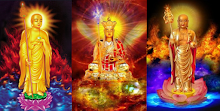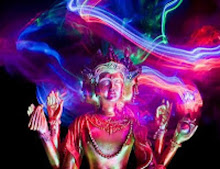 |
| Blissful, effervescent yogi as a result of persistent effort and letting go (yogatailor.com) |
 |
| When I began, it wasn't easy then a breakthrough |
In Buddhism a fully enlightened (bodhi) or awakened, a non-deluded or fully realized person is called an arhat (Pali, arahant). What does it mean?
It is the purification of view (ditthi), not personality. A person may continue to have his or her quirks, preferences, habits, and so on. The miraculous transformation that brings one from ordinary personhood into the Sangha of the Noble Ones (the Community of the Aryans) may not be visible at all to the casual observer. The Buddha said a person should not judge except after looking for a long time, reserving judgment and observing the person's character. It is not omniscience, not all-knowing awareness, not perfect perfection, not enlightened social views.
This is Buddhist "sainthood," but Buddhist saints are not like the saints of any other tradition. What is a "saint" to the world? It is someone who has temporarily suppressed the defilements and therefore appears "saintly" (moral, kind, wise, immaculate, and so on, often possessing mystic or magic powers to "prove" it. These things are all brought about by the jhanas, samadhi, and are very special but not necessary for full enlightenment.
It has a very precise meaning. Let us begin where we are -- in a state of delusion. We live in an illusion in the sense of not understanding what is actually there in front of us. What do we see? We see permanence, stability, solidity. We see enduring satisfaction, happiness, and fulfillment.
We see a self, identify with it, and imagine ourselves owners. An arhat is a spiritual practitioner who has realized four stages of attainment. The implications of the term vary based on the respective schools and traditions. The oldest surviving Buddhist school links these developmental stages to the dropping away of the ten bonds or "fetters" (samyojana). These are distinct from the Five Hindrances (nivarana), "taints" (asavas, cankers, inflows, outflows, biases), and defilements (kilesas).
It has a very precise meaning. Let us begin where we are -- in a state of delusion. We live in an illusion in the sense of not understanding what is actually there in front of us. What do we see? We see permanence, stability, solidity. We see enduring satisfaction, happiness, and fulfillment.
We see a self, identify with it, and imagine ourselves owners. An arhat is a spiritual practitioner who has realized four stages of attainment. The implications of the term vary based on the respective schools and traditions. The oldest surviving Buddhist school links these developmental stages to the dropping away of the ten bonds or "fetters" (samyojana). These are distinct from the Five Hindrances (nivarana), "taints" (asavas, cankers, inflows, outflows, biases), and defilements (kilesas).
- personality-belief or the wrong view that there is, ultimately speaking, a self
- pernicious skeptical doubt about the path
- clinging to the belief that enlightenment can be gained by the practice of mere rules and rituals
- sensuous craving or strong five-sense strand desire
- ill-will or aversion
- craving for fine-material existence
- craving for immaterial existence
- conceit, the subtle, persistent habit of conceiving in terms of self
- restlessness
- ignorance
There is no entering upon the first stage of enlightenment without an experiential grasp of not-self or egolessness. This is the hardest thing. And it is on account of it that the Buddha did not recognize "saints" in traditions outside the Dharma he made known. Indeed, there were very great beings with great attainments in concentration, wisdom, and mystical powers -- yet they were not free, liberated, emancipated from the cycle of rebirth and suffering. They were, at best, only temporarily sojourning in exalted heavens to fall again after staggering lifespans.
In many Christian schools today, "saint" simply means someone in heaven or guaranteed to be reborn in heaven. There are relatively few, while we comfort ourselves that every nice person ends up among the elect. The sad fact is that this is simply a comforting belief we cling to because the truth, and our associated views, are too much to bear.
- Meditators free of the first three bonds are stream-enterers or stream-winners -- capable of being reborn a maximum of seven more times, guaranteed to become arhats.
- Those who have in addition abandoned the grosser forms of the fourth and fifth as well are called once-returners, who might return to (be reborn in) this world, the lowest good rebirth within the Sensual Sphere, no more than once.
- Those who are fully freed from the first five "lower" fetters (binding beings to the Sensual Sphere) are non-returners, who do not return to (are not reborn in) this sphere.
- Those who are freed from all ten bonds are called arhats, that is, worthy ones, perfected ones, "holy" (whole, with integrity, integrated, wholesome) or accomplished ones.
In the Early Buddhist schools
 |
| Bodhisattva Simpson (Concerning Art) |
According to A.K. Warder, the Sarvāstivādins held the same position as the Mahāsāṃghika branch regarding arhats, considering them imperfect and fallible.[14]
The Kāśyapīya school also held the doctrine that arhats were fallible and imperfect, similar to the view of the Sarvāstivādins and the various Mahāsāṃghika sects.[15] Moreover, the Kāśyapīyas believed that arhats have not fully eliminated desires, that their "perfection" is incomplete, and that it is possible for them to relapse.[16]
How the word is derived
 |
| Guru Homer (livejournal.com) |
This has been challenged by more recent research. Comparing ancient Indian forms arahanta and arihanta[2] in Pali and early Jain Prakrit languages results in the alternative etymology "foe-destroyer" or "vanquisher of enemies."
This corresponds to the Jain definition.[3] The latter challenges the assumption that the root of the word is Pali araha (Sanskrit, arha). Richard Gombrich has proposed an etymology of ari + hanta, bringing the root meaning closer to jina (an epithet commonly used for both the Buddha and Mahavira, the leaders of the Jains and Buddhists.[4]
Arhat was translated into East Asian languages phonetically as a transliterated term, exemplified in the Chinese āluóhàn, often shortened to simply lohan. However, the Tibetan term was translated by meaning from Sanskrit as dgra bcom pa, which translates as, "one who has destroyed the foes of afflictions."[5] This Tibetan translation of the meaning conforms with the Jain definition as well.
Arhat occurs as arhattā in the Rigveda[6] and as the first offer of salutation in the main Jain prayer, the Namokar Mantra.
Based on a possible Sanskrit etymology, Arhant can be translated as
deathless since hant in Sanskrit means "death or killing" and ar is
often used for negation, implying "cannot be killed" or "beyond death"
or "deathless."
- Buddhist Podcast, June 10, 2025; Dhr. Seven, Amber Larson, Pat Macpherson (eds.), Wisdom Quarterly Wiki edit Arhat (Buddhism), 7/11/12


















































































































































































































































No comments:
Post a Comment